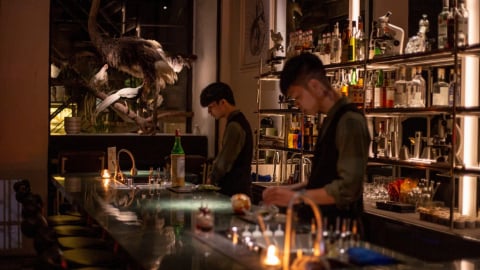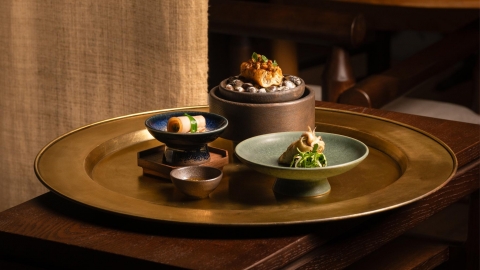Essentially, a separate drink menu plays the role of connecting dishes in a fixed menu structure, while helping diners explore the flavors of each dish more deeply. Even the chef's culinary creativity is sometimes expressed excellently when there is a specially designed drink menu.
From wine, cocktails, to non-alcoholic pairings like juice pairings... high-end restaurants today strive to bring diverse and consistent experiences to diners. They do not want to serve a perfect food menu, but are limited by too stereotypical drinks such as mineral water, soft drinks and bottled beer and wine.

Today's fine dining restaurants strive to offer a diverse and consistent experience to their diners.
A successful tasting menu is not just a series of carefully arranged dishes, but a story, a discourse of taste. The beverage menu acts as a “dialogue” with each chapter of that story.
When a glass of wine, a cocktail or a homemade juice appears with a dish, it does not only complement the flavor but also highlights, balances or deliberately contrasts the main ingredients, sauces, textures and temperatures of the dish. Basic principles such as flavor balance, spice interactions, textural correspondence and lingering aftertaste... are all considered and arranged harmoniously.

In a fine dining restaurant, the drink menu (wine/juice pairing) is not a random addition for customers to "drink for the sake of it".
From traditional pairing to a diverse drinks palette: the expansion of the pairing concept
In the past, “pairing” in high-end restaurants was often synonymous with wine. Red wine with red meat, white wine with white meat and seafood. But in recent years, the concept of “pairing” has expanded more than ever to include cocktails, homemade juices, kombucha, non-alcoholic fermented water... even pairing with the spirit of “drinks of origin” (drinks made from local ingredients, fermented locally) appearing at top restaurants.

Many renowned chefs and restaurants have taken the initiative to experiment with creating drink menus that both enhance their dishes and cater to the diverse needs of their customers. This expansion increases the creativity of the beverage sector and expands the customer base of these restaurants.
In Vietnam, some fine dining restaurants such as Gia Hanoi, Lamai or TUNG Dining, Mien, Nen Light, The Monkey Gallery DINING... all have specially made drinks to serve their seasonal menus. At Gia, Chef Nhung Tran has made many interesting drinks such as "soy milk", filter cocktail or unique kombucha. Or Chef Trung Tran of Lamai shows his creativity through making his own daily juice (juice of the day)...
A drink menu not only needs to be “tasteful” but also needs to have aesthetic elements from the name, the standard way of telling a story, separate glasses (serveware), the order of service, and the language used when the sommelier (wine consultant) or staff describes. A well-written wine or separate drink menu can tell the story of the land, the season, or the restaurant’s culinary thinking and it is what makes the difference in the minds of customers. At a higher level, this drink menu can be a brand mark expressed in many ways such as proactively exclusive a few rare bottles, creating signature drinks…


The drink menu not only needs to be "tasteful" but also needs to have aesthetic elements from the name, standard "story telling", and separate cups (serveware).
Practical factors: finance, logistics and operations
The economic aspect cannot be ignored when talking about the F&B market. We see that a good beverage menu can increase the average revenue per customer very high. Usually, this menu is priced according to a small discount structure but many dishes (small-pour tasting) to optimize revenue. At the same time, selling drinks according to the "pairing menu" helps restaurants control the use of bottles according to the dosage, limit plastic and glass waste from industrial drinks and optimize inventory.

However, each restaurant needs complex management to operate because operating and maintaining this unique menu requires more manpower and time than usual. Restaurants can choose to produce their own drinks such as soaking fruits to make juices, wines and fermented foods, as well as making their own teas and craft beers or ordering from reputable suppliers. For wine, high-end restaurants will usually work with a dedicated wine expert (sommelier). If implemented properly, a custom-designed drink menu can bring in a significant amount of revenue for the entire operating system.

A great restaurant understands that designing a beverage menu is rarely a one-way street. Efficiency comes from constant communication between the sommelier and chef. They taste, adjust the order, tweak portion sizes, even change small ingredients on the plate to match the chosen beverage. In many fine dining establishments, there are intense meetings to prepare a new menu. This refers to the entire food and beverage menu, not just the “food.” The result is a coherent whole, not two separate menus. The journey itself is a valuable creative part, and is often recognized by discerning diners.
Drink menu and restaurant social responsibility sustainability
As customers demand transparency about provenance and environmental impact in the emerging sustainable dining trend, each tailored beverage menu is also something they care about. From choosing clean, “sustainably” produced wines from vineyard to table, local cocktail ingredients, using seasonal fruit for juice pairings, and reducing unnecessary imported bottles, all are acts of responsibility. This not only aligns with the trend of conscious consumption, but also connects the restaurant to the local production community. Trendy restaurants are building their beverage lists as a sustainable value chain, from farm to glass.

Challenges to consider when implementing
The most important thing comes from cost and risk. When a restaurant diversifies its drinks, they incur high warehousing costs and the risk of stockpiling if they mispredict demand. Next, training human resources is also an obstacle as not all service staff are capable of presenting ideas from such unique menus, requiring a sommelier with certain expertise.
Another interesting but sensitive thing is the selling price of a drink menu. They should not be too high, even only about 35% - 40% of the price of the food menu, but still have to ensure high-class, high-quality ingredients and create many unique experiences.

The beverage menu in fine dining has moved from a supporting role to a "co-creator of the menu". It helps diners have more experiences, at the same time expands the customer base, increases business efficiency and is a mirror reflecting the values (aesthetic, ethical and professional) of the restaurant.
In an increasingly fragmented culinary world where customers seek both emotional value and transparency and sustainability, a beverage menu curated by sommeliers who understand the kitchen and understand the customer psychology will be one of the factors that determine the true reputation of a fine dining restaurant.

































